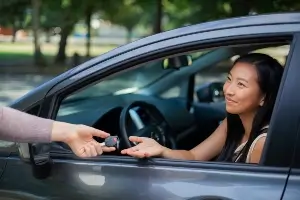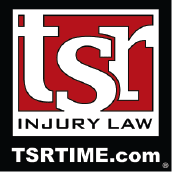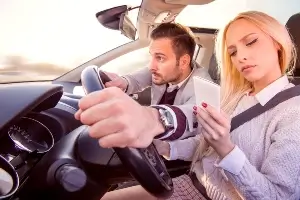Who Pays When Teen Drivers Cause Car Crashes in Minnesota?
 Teen drivers cause thousands of crashes across Minnesota each year, over 11,000 in 2024, leaving victims with serious injuries and unexpected financial costs. Even if a crash occurs because of a teen’s inexperience behind the wheel, you still need to be compensated for your damages. So, who pays in this situation?
Teen drivers cause thousands of crashes across Minnesota each year, over 11,000 in 2024, leaving victims with serious injuries and unexpected financial costs. Even if a crash occurs because of a teen’s inexperience behind the wheel, you still need to be compensated for your damages. So, who pays in this situation?
At TSR Injury Law, we are native Minnesotans who are deeply committed to helping victims injured by driver negligence. Our experienced car crash lawyers based in Minneapolis understand the unique laws involving teen drivers, including what insurance may apply. Despite the young age of a teen driver, we put our clients first and work hard to ensure you recover the full and fair compensation you need and deserve.
Need legal help after a crash with a teen driver? We have the staff and resources to fully investigate and manage your case from day one. Call for a free case review today – we welcome your questions and can help you understand your legal options.
Fill out our short, confidential evaluation form online or call (612) TSR-TIME to request a free case review today.
Are Teens Always Assumed at Fault After a Car Crash in Minnesota?
Minnesota law does not automatically assume any teen driver is at fault simply because of their age or inexperience behind the wheel. When determining who caused a crash, investigators and Minnesota courts must examine the specific facts and evidence of each case.
Teen drivers face the same legal standards as adult drivers when courts determine fault for a car crash. Insurance companies and attorneys must prove negligence through evidence, such as police reports, witness statements, traffic violations, and physical evidence, from the crash scene.
While inexperience may often contribute to crashes involving young drivers, Minnesota law requires actual proof of negligent behavior rather than presumptions based on age alone.
Do Parents Pay for Damages If Their Teen Causes a Crash in Minnesota?
Minnesota is a no-fault state, so your own insurance will cover your initial medical bills and some lost wages, no matter who caused the crash. Any economic losses that exceed your insurance coverage need to be recovered against the at-fault party’s insurance. In cases involving a teen driver, you would likely sue the parents as most teens drive their parents’ cars and are covered under their parent’s auto insurance policy as a listed driver.
Can I Still Sue the Parents If a Teen Driver Has Their Own Insurance?
Teens don’t usually have their own insurance policies due to cost considerations. However, if a teen does have their own insurance, you may still be able to sue the parents. To start with, Minnesota liability coverage follows the car, so if the vehicle belongs to the teen’s parents, they can still be held financially responsible.
At TSR Injury Law. Our experienced legal team has decades of experience and extensive knowledge of complex state and insurance laws, including how they may apply to your situation.
How Does Minnesota’s No-Fault Insurance Affect My Ability to Sue After a Crash With a Teen Driver?
While PIP covers your initial medical bills and lost wages – regardless of fault – the liable party (even if it is a teen driver) is financially responsible for damages that exceed your insurance coverage, including:
- Reasonable and related medical costs
- Property damage
- Lost wages
You may also be eligible to recover non-economic damages, but there are certain state threshold requirements you must meet first, including:
- Medical costs for your injuries exceed $4,000
- You sustained a permanent injury or disfigurement
- Total disability for 60 days or more
- The crash caused fatal harm to a loved one
How Much Can Parents Be Sued for if Their Teen Driver Causes a Crash?
Minnesota does not have a cap on damages, but the amount parents can be sued for generally depends on their degree of negligence and the extent of damages victims incurred.
Key circumstances where parents may be liable:
- Negligent “Entrustment: May apply if parents allowed a teen with a known history of reckless or careless driving to use their car.
- Unsafe Vehicle: If it contributes to the crash, parents may be liable for allowing a teen to take a car that has not been properly maintained or is known to be unsafe (such as having old tires or faulty brakes).
- Vehicle Ownership: If the vehicle being driven by a teen at the time of the crash is owned by a parent.
- Allowing an Unlicensed Teen to Drive: If a parent knowingly allows a teen to drive without a license.
Does Vicarious Liability Apply to Parents in Minnesota if Their Teen Driver Causes a Crash?
Yes, vicarious liability applies in Minnesota when parents own the vehicle their teen was driving. Under this legal doctrine, parents become automatically responsible for damage their teen causes while operating the family car, even if they didn’t give permission for that specific trip.
Minnesota applies vicarious liability through the owner liability principle. Under this law, vehicle owners are liable for damages caused by drivers who use their car with permission. Since teens typically have implied permission to drive family vehicles, parents are considered liable if their teen causes a crash in that situation.
The vicarious liability law ensures crash victims have a viable source of compensation when teen drivers cause serious injuries. Minnesota upholds the law that parents who provide vehicles to teen drivers should bear financial responsibility if they allow them to drive and it leads to a crash.
Insurance Coverage Parents of Teen Drivers Must Carry in Minnesota
Minnesota requires all vehicle owners, including parents with teen drivers, to carry minimum liability insurance coverage. Parents must maintain adequate coverage when their teens begin driving to comply with state law and protect their family’s financial assets.
What Is the Minimum Auto Insurance Coverage Required by the State?
Minnesota mandates specific minimum insurance coverage for all drivers. The required minimums include $30,000 per person for bodily injury, $60,000 per occurrence for bodily injury, and $10,000 for property damage. Parents must also carry Personal Injury Protection coverage of at least $20,000 for medical and $20,000 for wage loss as well as uninsured motorist coverage with minimum limits of $25,000 per person and $50,000 per occurrence.
Parent’s Must Notify Their Insurer as Soon as a Teen Gets Their License
Parents must immediately notify their insurance company when their teen gets their driver’s license. Insurance companies require this notification to properly assess risk and adjust coverage accordingly. Failing to report a new teen driver can void coverage and leave parents personally liable for any crashes their teen causes.
Why Minimum Coverage Often Is Not Enough With a Teen Driver
Minimum insurance coverage is typically inadequate when teen drivers cause serious crashes. Medical expenses for severe injuries often easily exceed the available coverage. This can leave parents personally liable for damages beyond their insurance limits. This can be devastating to the family of a teen driver who causes a car crash. Hospital bills, rehabilitation costs, and lost wages can quickly reach hundreds of thousands of dollars in serious crash cases.
How Teen Drivers Increase Insurance Premiums
Adding a teen driver to a family’s insurance policy generally increases premiums by 50 to 100 percent. Insurance companies recognize that inexperienced drivers pose significantly higher crash risks than seasoned adult drivers. Parents cannot avoid these increased costs by keeping teens off their policy if the teen regularly drives family vehicles.
How Likely Is It Your Teen Will Cause a Crash?
As parents, we hope our teens don’t get involved in a crash or cause a crash due to careless or reckless behavior. But teen drivers have a greater risk of getting into a collision than experienced drivers simply because of their inexperience and still developing decision-making skills. Young drivers also have a harder time recognizing dangerous situations on the road. This elevated crash risk directly impacts parents through increased liability exposure and higher insurance costs.
Need Legal Help for a Crash With a Teen Driver? Call TSR Injury Law Today
At TSR Injury Law, we are here to help you after a crash involving a negligent driver, including teens. Despite their young age and inexperience, we work to hold teens and their parents financially accountable if their negligence caused your car crash and resulting damage.
Worried about the costs of hiring a lawyer? Don’t be – we take injury cases on contingency. Essentially, this means we take on the risks up front so you don’t have to. There are no upfront costs or fees to pay. We only get paid if you do.
Call (612) TSR-TIME today. We are serious about getting results and would be honored to help you.


 Teen drivers have a much higher risk of being involved in a crash than more seasoned adult drivers. There are many reasons for this increased risk, from the still-developing brain patterns of young teens to inexperience handling Minnesota’s challenging road conditions.
Teen drivers have a much higher risk of being involved in a crash than more seasoned adult drivers. There are many reasons for this increased risk, from the still-developing brain patterns of young teens to inexperience handling Minnesota’s challenging road conditions. Traffic safety officials across the country call summer months the “100 Deadliest Days” because fatal car crashes spike dramatically on Minnesota roads and across the country during this time.
Traffic safety officials across the country call summer months the “100 Deadliest Days” because fatal car crashes spike dramatically on Minnesota roads and across the country during this time.